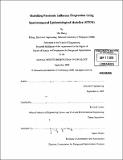| dc.contributor.advisor | Richard Larson. | en_US |
| dc.contributor.author | Zhang, Hui, S.M. Massachusetts Institute of Technology | en_US |
| dc.contributor.other | Massachusetts Institute of Technology. Computation for Design and Optimization Program. | en_US |
| dc.date.accessioned | 2010-05-25T20:40:25Z | |
| dc.date.available | 2010-05-25T20:40:25Z | |
| dc.date.copyright | 2009 | en_US |
| dc.date.issued | 2009 | en_US |
| dc.identifier.uri | http://hdl.handle.net/1721.1/55088 | |
| dc.description | Thesis (S.M.)--Massachusetts Institute of Technology, Computation for Design and Optimization Program, 2009. | en_US |
| dc.description | Cataloged from PDF version of thesis. | en_US |
| dc.description | Includes bibliographical references (p. 69-70). | en_US |
| dc.description.abstract | The purpose of this project is to incorporate a Poisson disease model into the Spatiotemporal Epidemiological Modeler (STEM) and visualize the disease spread on Google Earth. It is done through developing a Poisson disease model plug-in using the Eclipse Modeling Framework (EMF), a modeling framework and code generation facility for building tools and other applications based on a structured data model. The project consists of two stages. First, it develops a disease model plug-in of a Poisson disease model of a homogenous population, which is built as an extension of the implemented SI disease model in the STEM. Next, it proposes an algorithm to port a Poisson disease model of a heterogeneous population into the STEM. The development of the two new diseases plugins explores the maximum compatibility of the STEM and sets model for potential users to flexibly construct their own disease model for simulation. | en_US |
| dc.description.statementofresponsibility | by Hui Zhang. | en_US |
| dc.format.extent | 75 p. | en_US |
| dc.language.iso | eng | en_US |
| dc.publisher | Massachusetts Institute of Technology | en_US |
| dc.rights | M.I.T. theses are protected by
copyright. They may be viewed from this source for any purpose, but
reproduction or distribution in any format is prohibited without written
permission. See provided URL for inquiries about permission. | en_US |
| dc.rights.uri | http://dspace.mit.edu/handle/1721.1/7582 | en_US |
| dc.subject | Computation for Design and Optimization Program. | en_US |
| dc.title | Modelling pandemic influenza progression using Spatiotemporal Epidemiological Modeller (STEM) | en_US |
| dc.type | Thesis | en_US |
| dc.description.degree | S.M. | en_US |
| dc.contributor.department | Massachusetts Institute of Technology. Computation for Design and Optimization Program | |
| dc.identifier.oclc | 587614987 | en_US |
